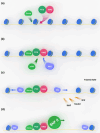Key features of the POU transcription factor Oct4 from an evolutionary perspective
- PMID: 34698883
- PMCID: PMC11072838
- DOI: 10.1007/s00018-021-03975-8
Key features of the POU transcription factor Oct4 from an evolutionary perspective
Abstract
Oct4, a class V POU-domain protein that is encoded by the Pou5f1 gene, is thought to be a key transcription factor in the early development of mammals. This transcription factor plays indispensable roles in pluripotent stem cells as well as in the acquisition of pluripotency during somatic cell reprogramming. Oct4 has also been shown to play a role as a pioneer transcription factor during zygotic genome activation (ZGA) from zebrafish to human. However, during the past decade, several studies have brought these conclusions into question. It was clearly shown that the first steps in mouse development are not affected by the loss of Oct4. Subsequently, the role of Oct4 as a genome activator was brought into doubt. It was also found that the reprogramming of somatic cells into induced pluripotent stem cells (iPSCs) could proceed without Oct4. In this review, we summarize recent findings, reassess the role of Oct4 in reprogramming and ZGA, and point to structural features that may underlie this role. We speculate that pluripotent stem cells resemble neural stem cells more closely than previously thought. Oct4 orthologs within the POUV class hold key roles in genome activation during early development of species with late ZGA. However, in Placentalia, eutherian-specific proteins such as Dux overtake Oct4 in ZGA and endow them with the formation of an evolutionary new tissue-the placenta.
Keywords: ESCs; NSCs; Oct4; Pluripotency; Reprogramming; Zygotic genome activation; iPSCs.
© 2021. The Author(s), under exclusive licence to Springer Nature Switzerland AG.
Conflict of interest statement
The authors declare that they have no competing interests.
Figures




Similar articles
-
Role of Oct4 in maintaining and regaining stem cell pluripotency.Stem Cell Res Ther. 2010 Dec 14;1(5):39. doi: 10.1186/scrt39. Stem Cell Res Ther. 2010. PMID: 21156086 Free PMC article. Review.
-
Reptin regulates pluripotency of embryonic stem cells and somatic cell reprogramming through Oct4-dependent mechanism.Stem Cells. 2014 Dec;32(12):3126-36. doi: 10.1002/stem.1827. Stem Cells. 2014. PMID: 25185564
-
OCT4: dynamic DNA binding pioneers stem cell pluripotency.Biochim Biophys Acta. 2014 Mar;1839(3):138-54. doi: 10.1016/j.bbagrm.2013.10.001. Epub 2013 Oct 18. Biochim Biophys Acta. 2014. PMID: 24145198 Review.
-
A conserved Oct4/POUV-dependent network links adhesion and migration to progenitor maintenance.Curr Biol. 2013 Nov 18;23(22):2233-2244. doi: 10.1016/j.cub.2013.09.048. Epub 2013 Nov 7. Curr Biol. 2013. PMID: 24210613 Free PMC article.
-
Direct reprogramming of human neural stem cells by OCT4.Nature. 2009 Oct 1;461(7264):649-3. doi: 10.1038/nature08436. Nature. 2009. PMID: 19718018
Cited by
-
Correction to: 'The functional diversity of the POUV-class proteins across vertebrates' (2022) by Bakhmet and Tomilin.Open Biol. 2022 Nov;12(11):220306. doi: 10.1098/rsob.220306. Epub 2022 Nov 9. Open Biol. 2022. PMID: 36349550 Free PMC article.
-
Trans differentiating human adipose-derived mesenchymal stem cells into male germ-like cells utilizing Rabbit Sertoli cells: An experimental study.Int J Reprod Biomed. 2023 Apr 14;21(3):213-228. doi: 10.18502/ijrm.v21i3.13197. eCollection 2023 Mar. Int J Reprod Biomed. 2023. PMID: 37122886 Free PMC article.
-
The functional diversity of the POUV-class proteins across vertebrates.Open Biol. 2022 Jun;12(6):220065. doi: 10.1098/rsob.220065. Epub 2022 Jun 29. Open Biol. 2022. PMID: 35765816 Free PMC article. Review.
-
OCT4 Expression in Gliomas Is Dependent on Cell Metabolism.Curr Issues Mol Biol. 2024 Jan 25;46(2):1107-1120. doi: 10.3390/cimb46020070. Curr Issues Mol Biol. 2024. PMID: 38392188 Free PMC article.
-
The emergence of Sox and POU transcription factors predates the origins of animal stem cells.Nat Commun. 2024 Nov 14;15(1):9868. doi: 10.1038/s41467-024-54152-x. Nat Commun. 2024. PMID: 39543096 Free PMC article.
References
Publication types
MeSH terms
Substances
Grants and funding
LinkOut - more resources
Full Text Sources
Miscellaneous

